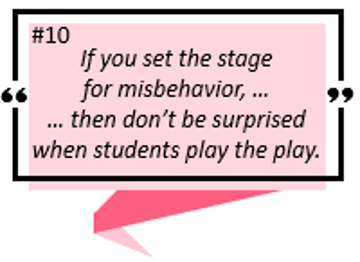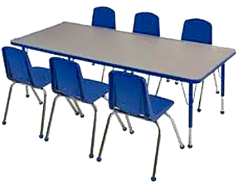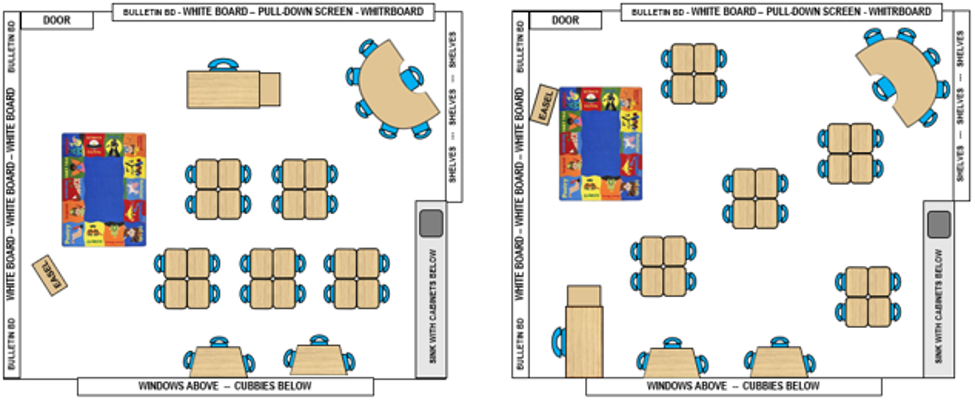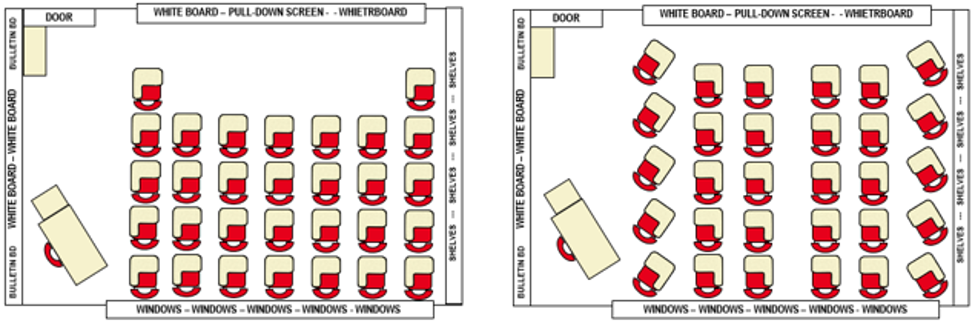30 Apr Word of Wisdom #10: Room Arrangement and Student Behavior
No such thing as a “neutral” room arrangement – any room arrangement either supports or detracts from student learning.

SETTING THE STAGE FOR LEARNING
The physical room arrangement sets the stage for learning – or not. No teacher deliberately “sets the stage” for students to misbehave. Yet I’ve seen more than one classroom where room arrangement encouraged behavior problems. It has to do with human behavior, and it applies to students of all ages – K through teachers in a staff development setting.
Furniture arrangements send signals of what is expected – and also of what might be gotten away with.
DENSITY AND ACCESS
Grocery shop with me for a few minutes. Given a choice of shopping at a store with narrow aisles and one with spacious aisles, which would you choose? How about one with shelf contents logically arranged and easy to access versus one where shelf contents are arranged haphazardly, with some needed items difficult both to find and to reach? No contest in either scenario.
Both scenarios illustrate principles of classroom arrangement repeatedly proven to influence student behavior: DENSITY and ACCESS.
The STUDENT DENSITY has nothing to do with how quickly students catch on. Rather, it translates to student personal space. We all love personal space. True, what we define as “enough” personal space may vary. But whatever our personal space boundary is, we want it. And when we don’t get it, crowding affects our comfort level, attitudes, and behavior.
True Story – Mine, All Mine!
I once coveted a student table in the classroom of a colleague. There, a small group of students otherwise seated in individual chair-desks could gather periodically for a variety of educational activities. When my colleague retired, her car wheels were not out of the parking lot on that last day before I was dragging that table and its six chairs down the hall and into my room.
At last! My very own student table! I enthusiastically set about working it into the existing space – that also house 32 student desks, a teacher desk, a file cabinet, and a cart with a projector. You guessed it: That room arrangement was really crowded. BUT – I had my table.
About three weeks into the year, I recognized that student behavior was becoming more of a challenge than in years past. To add that table, I had moved student desks closer together. Decreased aisle space resulted in increased student crowding – and student bickering. Moving to their seats, students now sometimes bumped into one another – and the boys bristled and the girls glared. NOT a good way to begin class. Students. By six weeks I finally admitted that my dearly desired student table was causing more problems than it was worth.
Studies show that crowding influences behavior. Lack of personal space tends to increase aggression in boys and paranoia in girls. Crowding students is counterproductive to their learning (see Capizzi, 2009).

Adding a dearly-desired group table created more problems than it solved.
COMPARING CLASSROOMS
QUESTION: Thinking about density and access, in which classrooms below would you rather be a student? Why?

Two possible room arrangements within an elementary classroom. Which one allow students more personal space and greater ease of access?

Two possible room arrangements within a secondary classroom. Which one allow students more personal space and greater ease of access?
ANSWER: Room arrangements to the right give students more personal space and access.
ONE SIZE DOES NOT FIT ALL
Often teachers ask me what is the “best” room arrangement. The answer is, “It depends.” It depends on multiple factors, including but not limited to
- Classroom size
- Classroom shape
- Furniture type
- Location of windows (and what is outside of them)
- Other possible distractors (e.g., classroom pets)
- Number of students
- Age of students (which relates to physical size)
- Type of activities you want students to do
For a thorough discussion of possible room arrangements addressing these factors, see https://www.displays2go.com/Article/Effective-Classroom-Seating-Arrangements-32. ( I wish this resource had been available when I was in the classroom!)
BUT WHAT IF THE ROOM IS JUST TOO SMALL?
Three things can help you deal with an overcrowded room arrangement.
- Go for the optical illusion that light colors create more space. A room with cream-colored walls seems larger than a room of the same size with dark blue walls. Get permission, paint, paint brushes, and painter volunteers.
- Go for the optical illusion that orderliness creates more space. A library bookshelf with books neatly organized in small, matching crates appears to take up less space than one with books haphazardly spilling out of it. The same is true of a science center with materials stored in neatly labeled and stacked boxes rather than spread out over a table. Obtain sets of storage crates/boxes/bins. If funds are short, cover similar size boxes with matching contact paper.
- Create one-way traffic lanes that guide student traffic flow. Just like one-way streets can alleviate traffic congestion, designating one-way traffic to and away from areas students frequently access (e.g., turn-in baskets, in-classroom water fountain), can prevent student congestion. Place one-way masking tape arrows on the floor to direct foot traffic patterns that prevent congestion as students come and go.
Until next week – may you experience success in all your academic endeavors!
Alene
Capizzi, A.M. (2096). Start the year off right: Designing and Evaluating a supportive classroom management plan,
Focus on Exceptional Children. Love Publishing Co. 2009. HighBeam Research. 7 Nov. 2018 <https://www.highbeam.com>.


